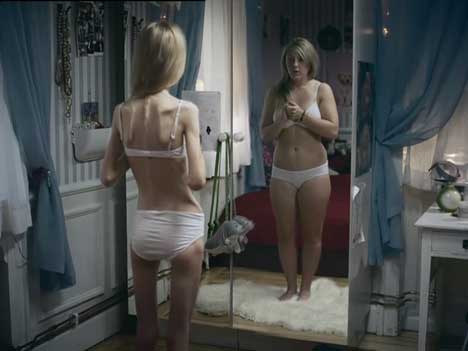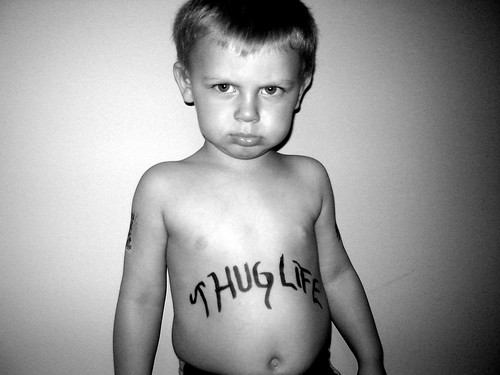Models – the ever-discussed topic in the realm of fashion. Are they too skinny or too fat? Do they really eat? Or are the myths about the triple C diet (cocaine, coffee, cigarettes) true? Unnatural bodies may be a common topic when discussing virtual realities and Barbie, but the reality is we see them on a daily basis – on magazine covers.
Photographs have since their birth had a big influence on peoples’ way of life. Photos have not only fixed and delimited time, but also started the creation of the visual culture we live in today. Marshall McLuhan definitely had a point when he stated that photos mirror the world (190). Never have designers’ ideals and models’ bodies been as questioned as they are today. The average American model was 5’11” and 117 lbs in 2008 (NEDA). However, I would like to twist and turn McLuhan’s argument slightly. These models are not merely photographs reflecting what people look like in society, but are at the same time advertisements trying to sell a brand and its’ accompanying ideology. This ideology is often something such as “thin is in”, or if you wear our clothes this and that is going to follow. As they show us what we ought to look like, we get skinnier, they once again show us how much skinnier should get, and many of us abide. As a result, an evil circle of representation of ideals is constructed. Young girls then, reach new weight extremes shown in the ramping statistics of both obesity and eating disorders (Stop Obesity; NEDA). This fact shows that we have become more self-critical and changed our “inner lives” to comply with our new set of standards (197).
I think it is time for us to question whether this kind of idealization in society is reasonable? We ask wherefrom the sudden increase in eating disorders comes, when all we need to do is look to visual media’s daily ubiquity (Women’s Health). The frustration of not being able to relate to what media shows us leaves us with this desperate urge to become able to identify. This frustration leads to an obsession, obsession with weighing as little as possible. Now, in a society where fitting into the two number weight categories is a merit, it is hard to consider as something natural. All of our bodies and these bodies in particular, are hence what Meirzoff would call Virtual bodies (116). They are bodies that undergo some kind of transformation from their once fundamental state. Mierzoff’s theory emphasizes the fact that media, and therefore our culture, influence our perceptions of beauty and its definition. “None of us inhabit a purely natural body and no one’s body is complete,” he further states (117). Suggested is then that not only virtual bodies, as found in online gaming worlds or better yet Second Life, are virtual per se. Rather, with today’s access to make-up, gyms, plastic-surgery and diets – we all virtualize our bodies to become something unnatural. Where do we draw the line?
The ubiquity of media cannot be the mere factor to the increasingly skinny models and the ideal they represent saturating our society. What made us abandon what I would like to call the “healthy virtual body” of the 50s – virtualized through make-up and hairspray at its most? The time where models represented the “average” woman with beautiful features has transformed to this below-size-zero society. I believe that the digitization of media has had a huge effect on this transition. The 50s beauties Marilyn Monroe and Sophia Loren are still considered beautiful women, yet what would they have looked like after Photoshop? Photos of today have taken us to an extreme where awareness of the digital modification of the original has become something natural, something original. We have “hyperrealized” our perception of ideals (Baudrillard 57); there is no longer an original. Nowadays, young women strive for the skeleton model bodies, which never seem to have a birthmark out of place or a sudden breakout. The process through which the original photo has gone through is irrelevant, because we identify with the virtualized version. Hence, Baudrillard’s point is proven, we live in a society where the copy is more real than the original. Living close to Hollywood, I saw a couple of “beautiful” actresses that indeed where as skinny, or even skinnier, than they looked on every photograph. But, they were not as “beautiful.” However, that did not stop me from having a subconscious urge to be as beautiful and skinny as they were on the pictures, not as seen in reality.
Another piece of “common knowledge” that we choose to surpass in our idealization with these fatless bodies, is that of the camera adding 10 pounds to one’s real weight. The models are therefore even skinnier than they look in the pictures, making the abnormality of their “weightlessness” even harder and striving for it virtual, as such. This was not a problem in the 50s, as the “natural” female was not seen as fat or skinny, merely beautiful. To clarify, it is not a coincidence that we refer to and know of Marilyn Monroe and Sophia Loren as “timeless beauties” and not Lara Stone.
Therefore, if the ideal is a result of a combination of ubiquitous media and digitization – what makes us young women overlook our awareness of the dangerous lifestyle of most models to fit in to this ideal? The “complete” body that Meirzoeff mentions no one has (117), if it were to be characterized today, it would be the body featured on every movie-cover and in every magazine – the thin body. The more I observe fashion magazines and ad campaigns, the more astonished I am of these girls ability to stay alive. Granted, models Ana Carolina Reston, Hila Elmalich, Maiara Galvao Vieira, Eliana and Luisel Ramos did not. They all died from, weighing as little as 60 pounds for a 5’6” body (Martin).
In conclusion, Marshall McLuhan, Jean Baudrillard and Nicholas Mierzoeff all predicted this happening and created a thesis as to why and how. Even though writing as long ago as almost 50 years and as “close” as 11 years ago, they were right – media has affected our inner perceptions as much as the level of superficiality we live after. How is it then that we, young women, are so reluctant to understand that we are being manipulated and pressured to unattainable and more importantly, unhealthy body ideals? We might look to virtual realities and other games when we speak about virtual bodies. Why bother when all we need to do is step to the closest mirror?
Mirror, mirror on the wall,
who's the thinnest of us all?

